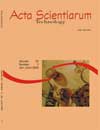<b>Evaluation of oat hull for biotechnological production of xylitol</b> - DOI: 10.4025/actascitechnol.v26i2.1509
DOI:
https://doi.org/10.4025/actascitechnol.v26i2.1509Keywords:
resíduos lignocelulósicos, casca de aveia, xilose, xilitol, Candida guilliermondiiAbstract
Oat, cereal rich in fiber, cultivated mainly in the South of Brazil, gives rise to 25-30% of its weight as oat hulls when it is processed for nourishing purposes, causing negative ambiental impact. Therefore, this residue can be used as raw material for obtaining products such as xylitol, a sugar-alcohol with sweetness similar to sucrose, anticariogenic, substitute for sugars in diabetic and obese people´s diet. This polyol is currently produced by chemical catalysis of the xylose obtained from lignocellulosic residue. However, the bioconversion by yeasts is an alternative for this process. This work aims to determine the chemical composition of the oat hulls and to use the acid hidrolysate from this residue for the xylitol production by batch fermentation employing Candida guilliermondii. Chemical analysis showed that oat hulls are composed by cellulose (29.26%), hemicellulose (28.35%) and lignin (22.22%), among others. The batch fermentation resulted in xylitol yield and volumetric productivity of 0.54 g/g and 0.34 g/L.h, respectivelyDownloads
Download data is not yet available.
Downloads
Published
2008-03-28
How to Cite
Tamanini, C., Oliveira, A. S. de, Felipe, M. das G. de A., Canettieri, E. V., Cândido, E. de J., & Hauly, M. C. de O. (2008). <b>Evaluation of oat hull for biotechnological production of xylitol</b> - DOI: 10.4025/actascitechnol.v26i2.1509. Acta Scientiarum. Technology, 26(2), 117–125. https://doi.org/10.4025/actascitechnol.v26i2.1509
Issue
Section
Biotechnology
License
DECLARATION OF ORIGINALITY AND COPYRIGHTS
I Declare that current article is original and has not been submitted for publication, in part or in whole, to any other national or international journal.
The copyrights belong exclusively to the authors. Published content is licensed under Creative Commons Attribution 4.0 (CC BY 4.0) guidelines, which allows sharing (copy and distribution of the material in any medium or format) and adaptation (remix, transform, and build upon the material) for any purpose, even commercially, under the terms of attribution.
Read this link for further information on how to use CC BY 4.0 properly.











8.png)




